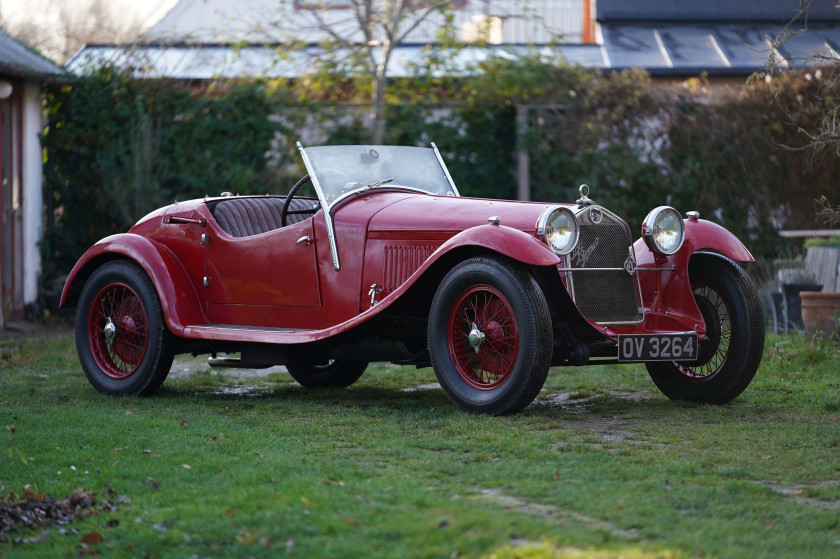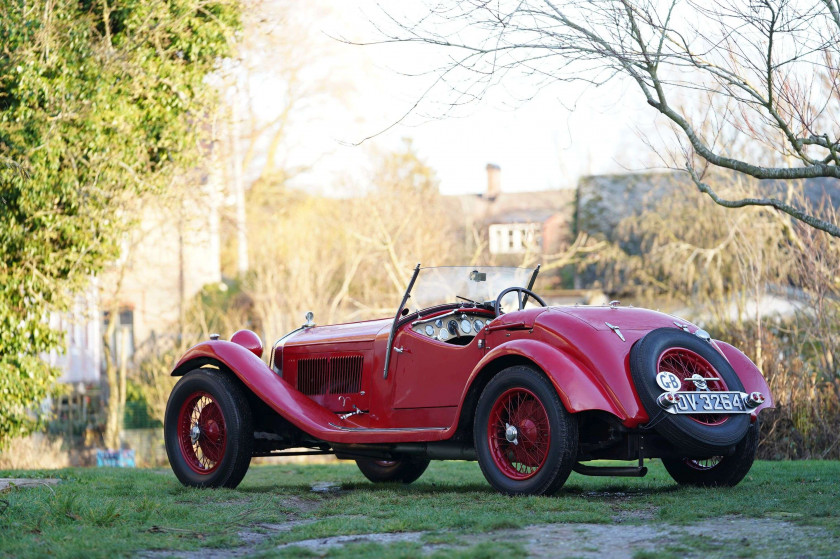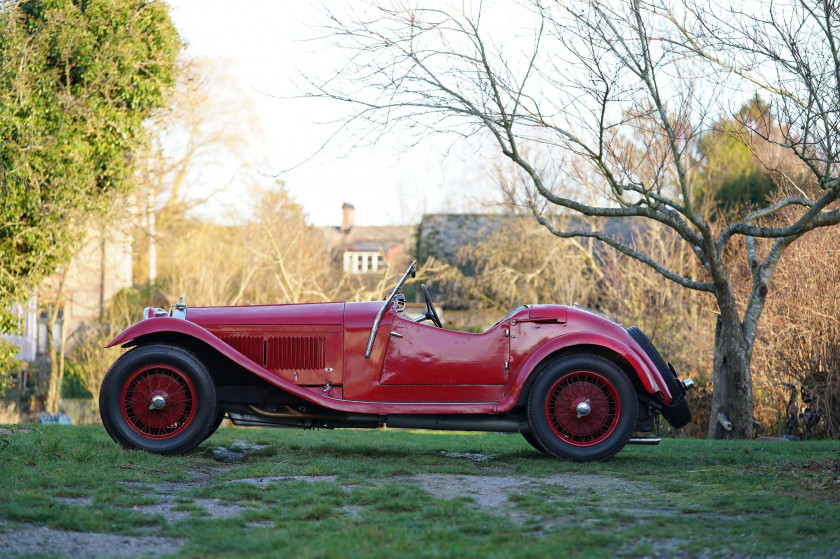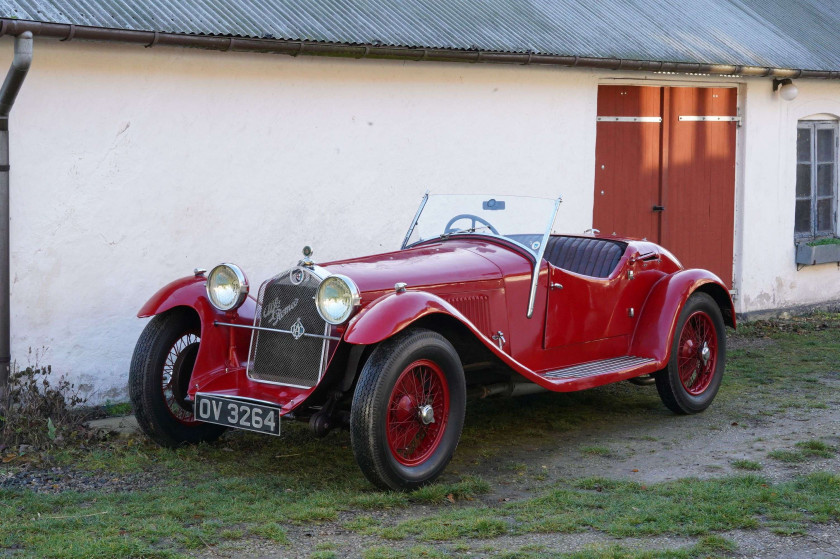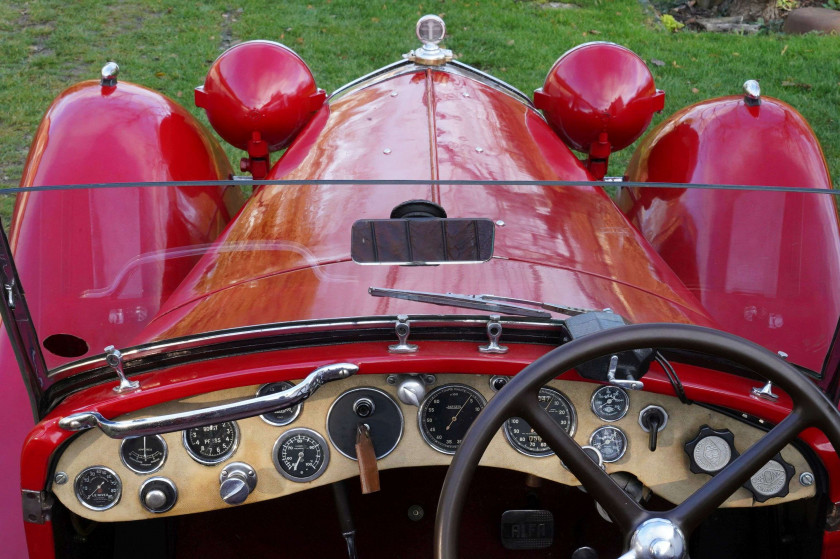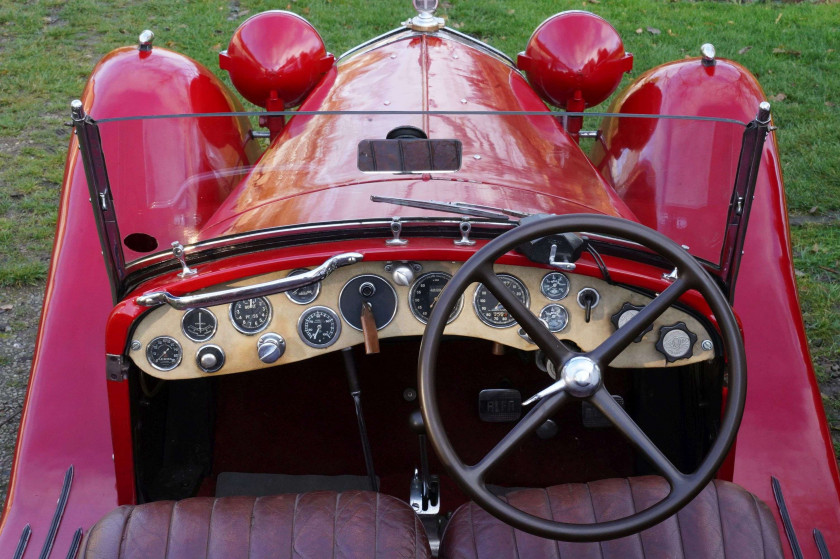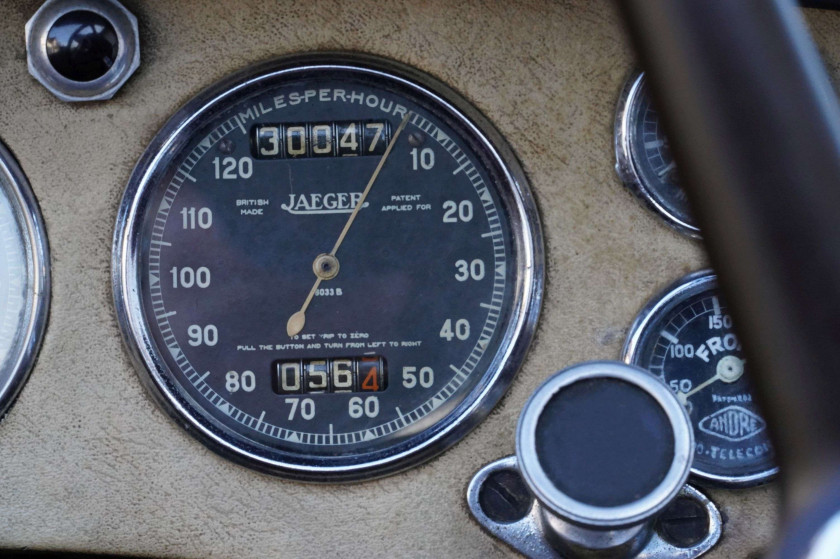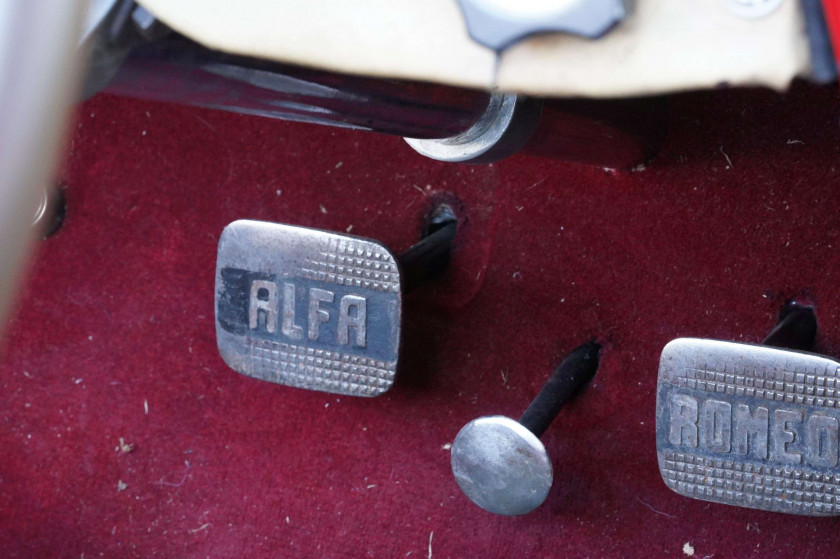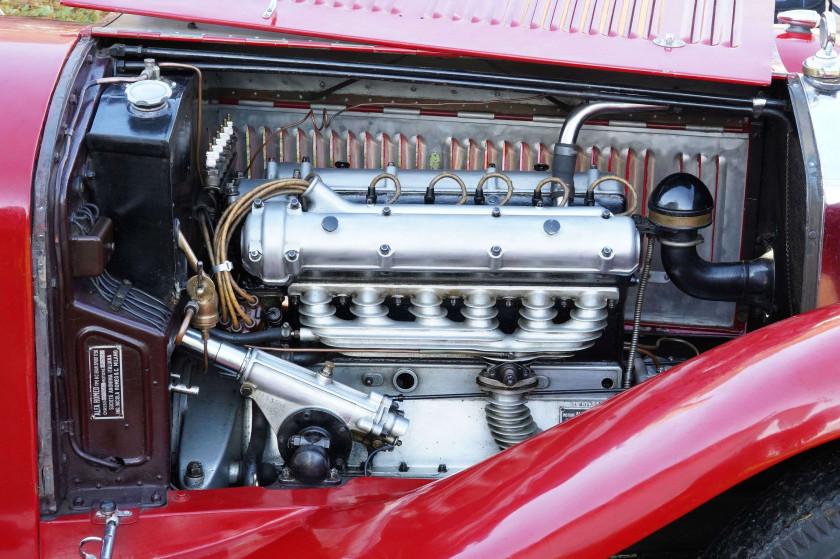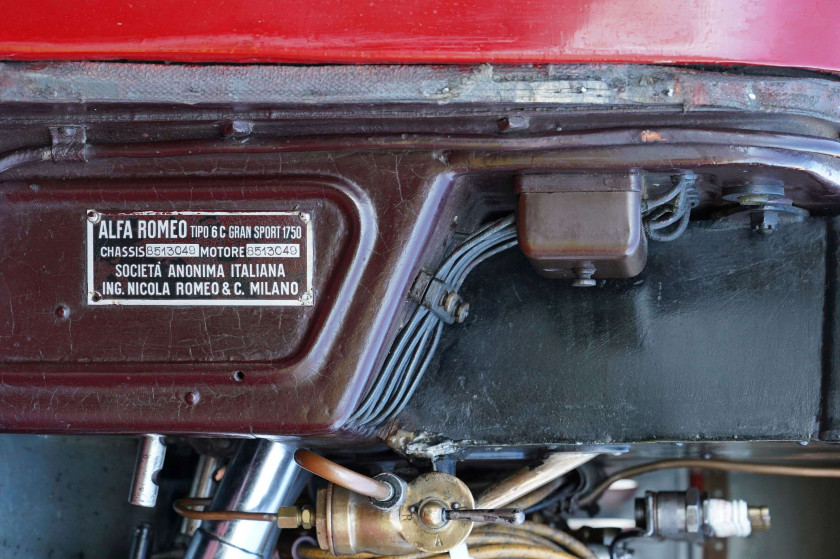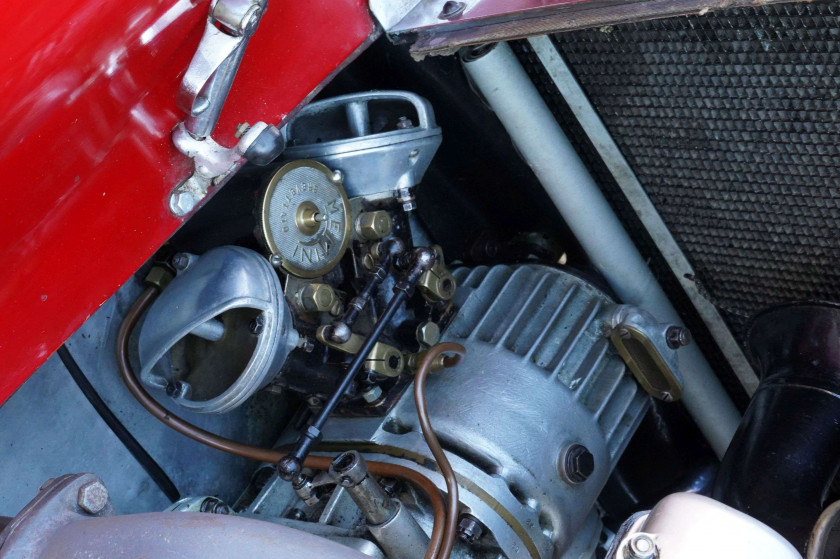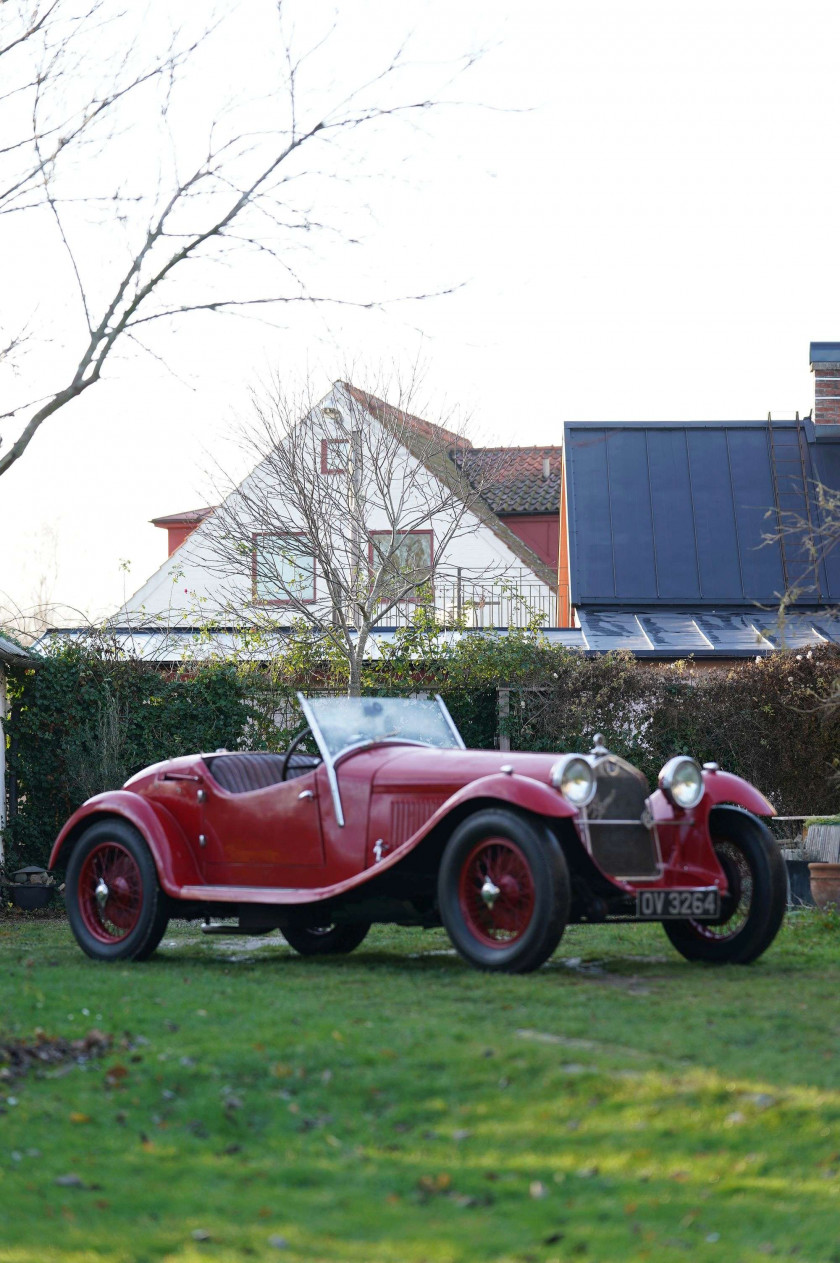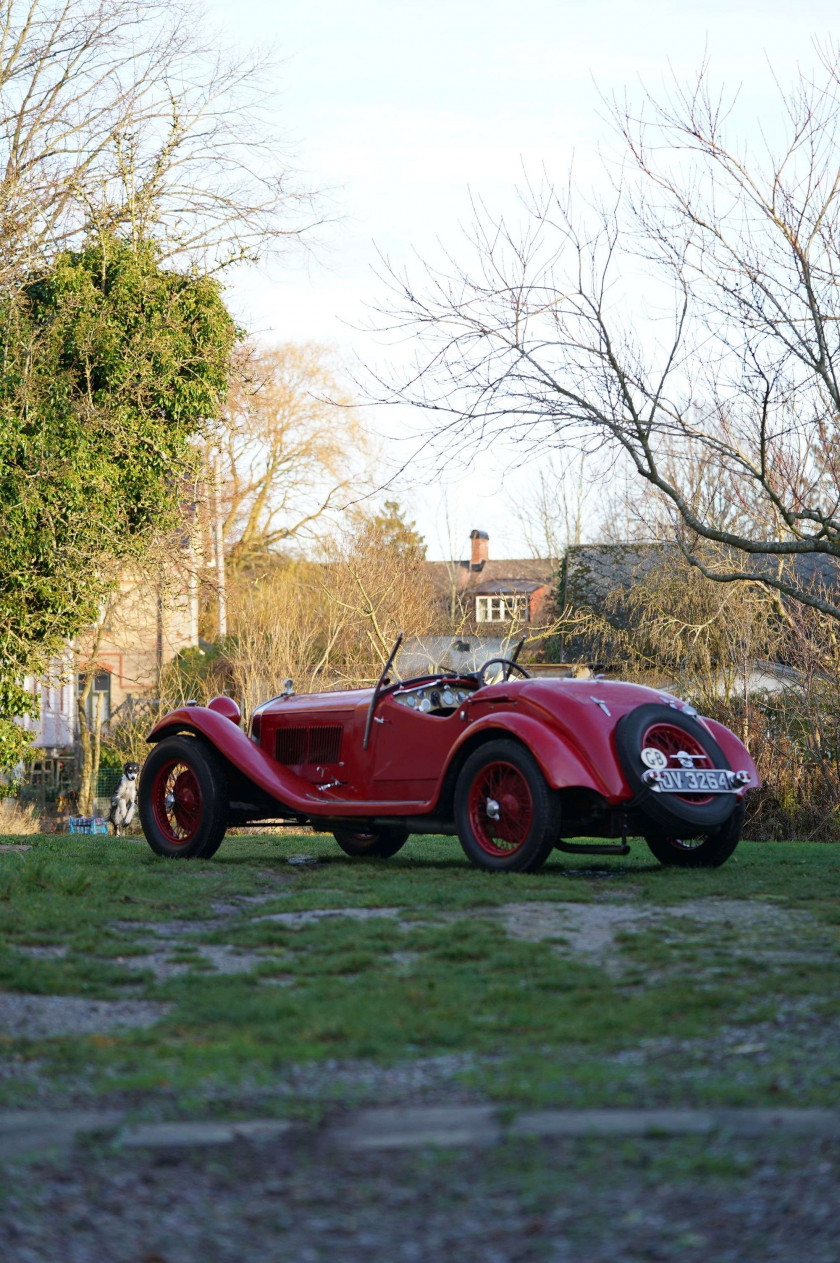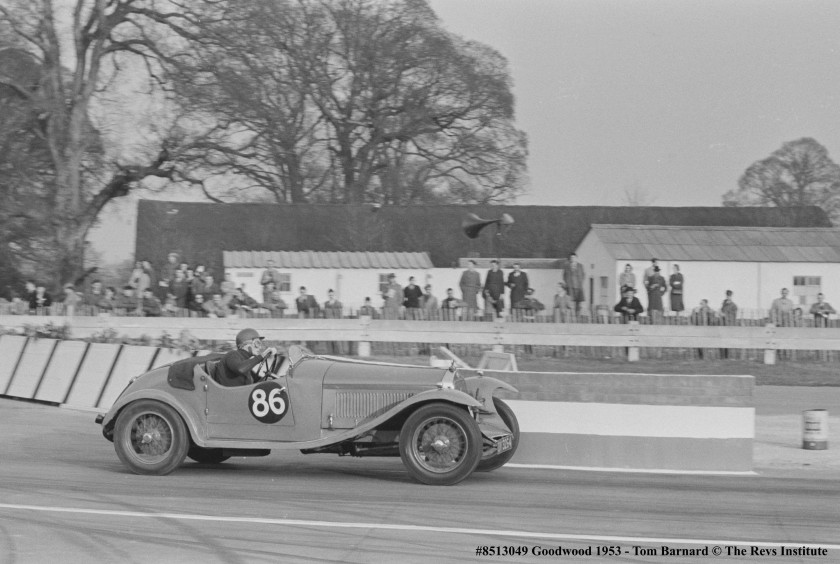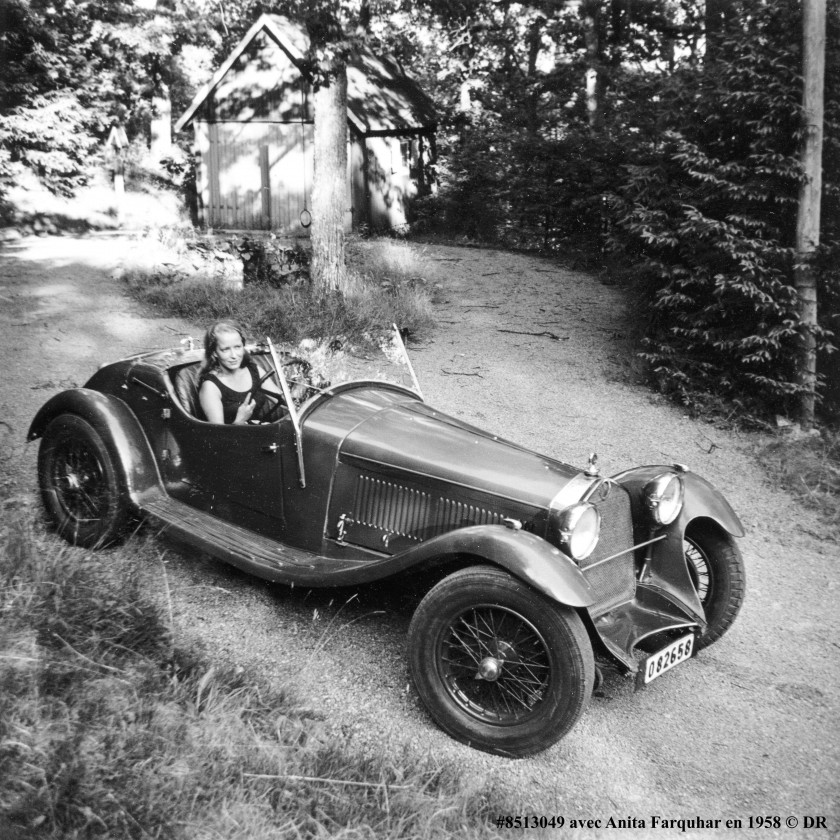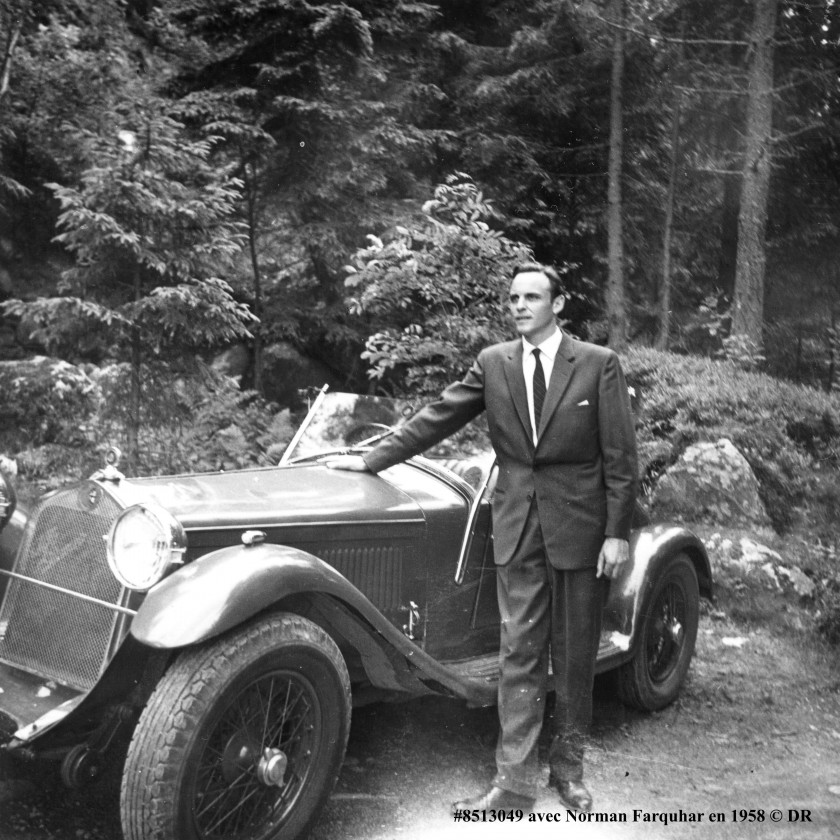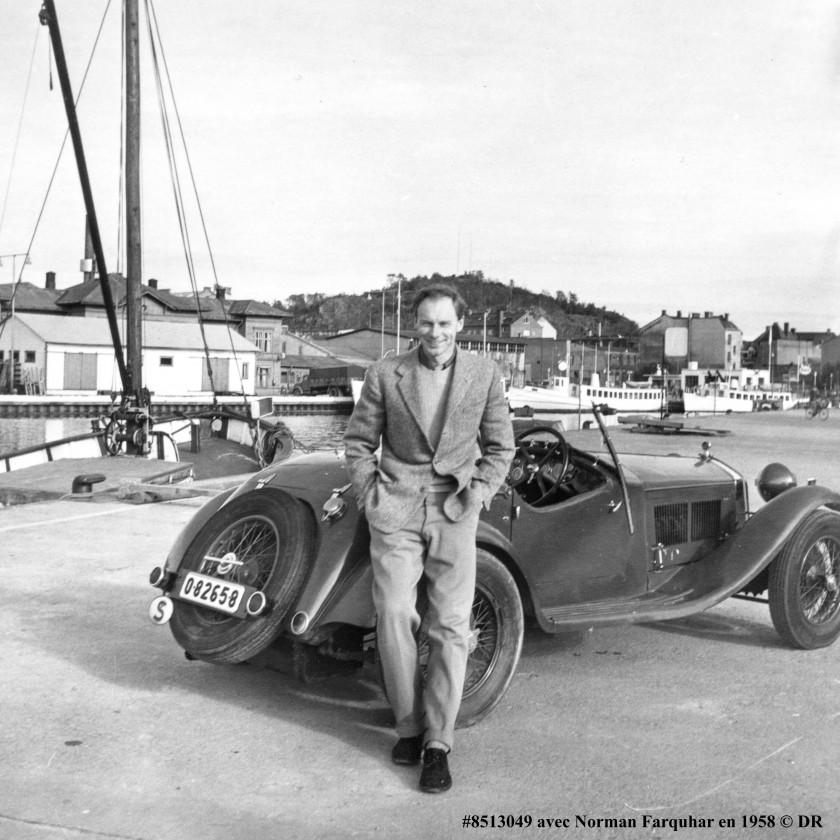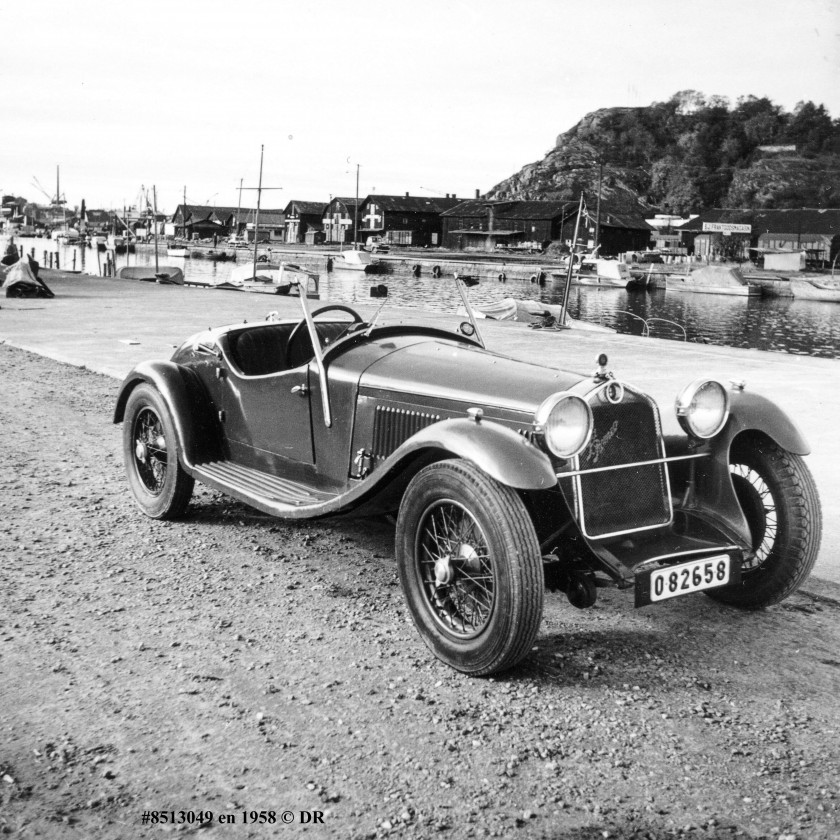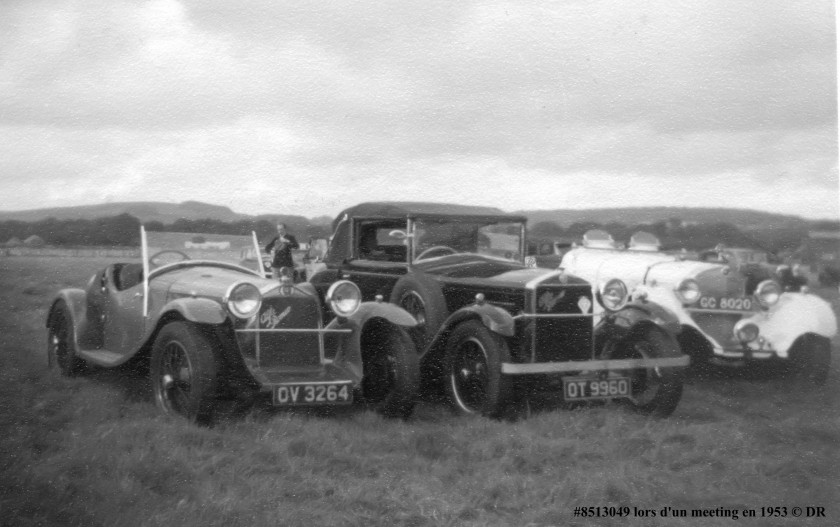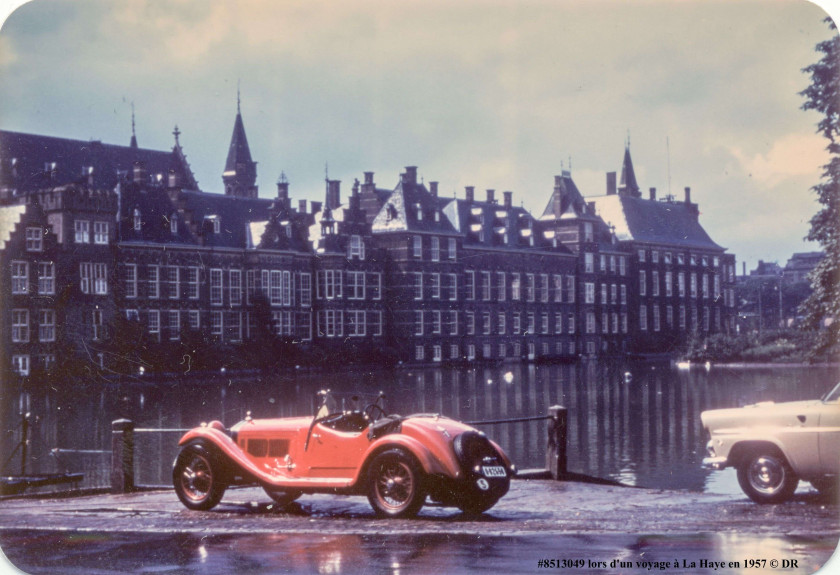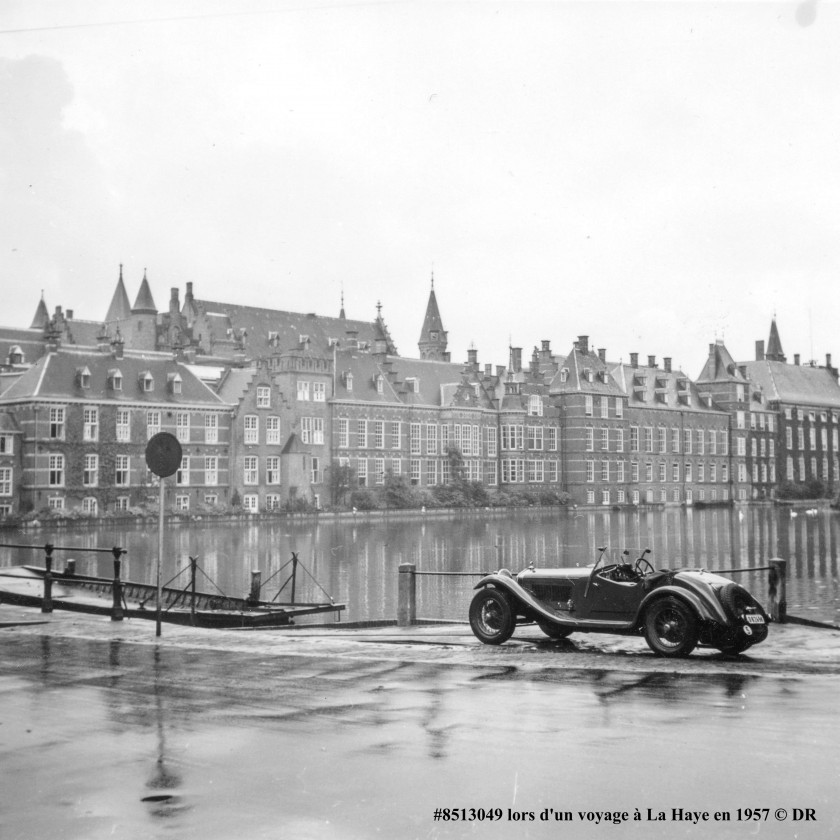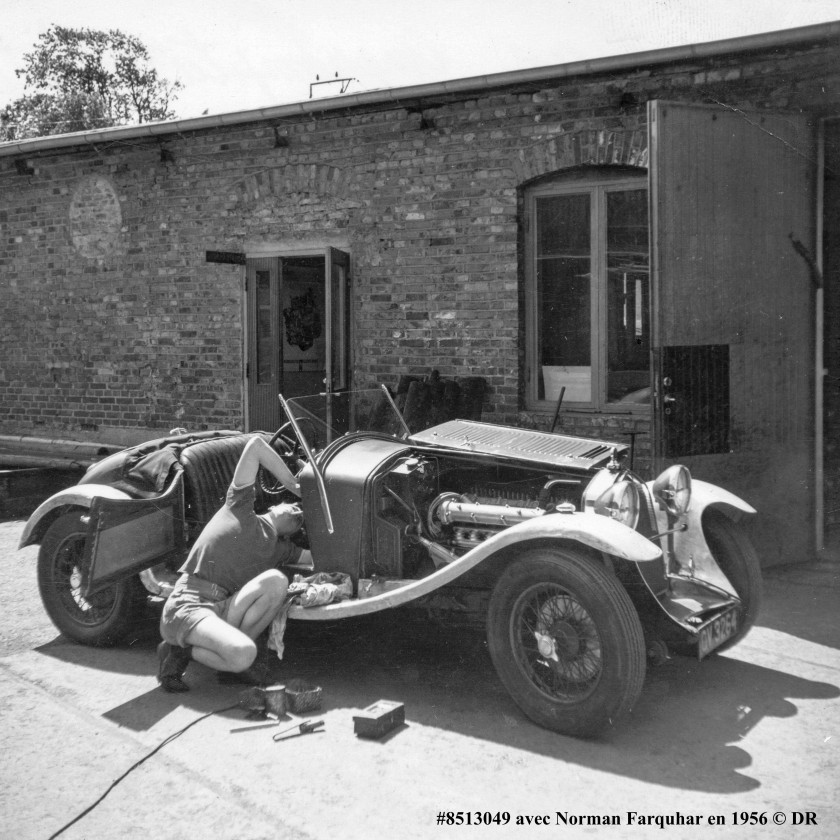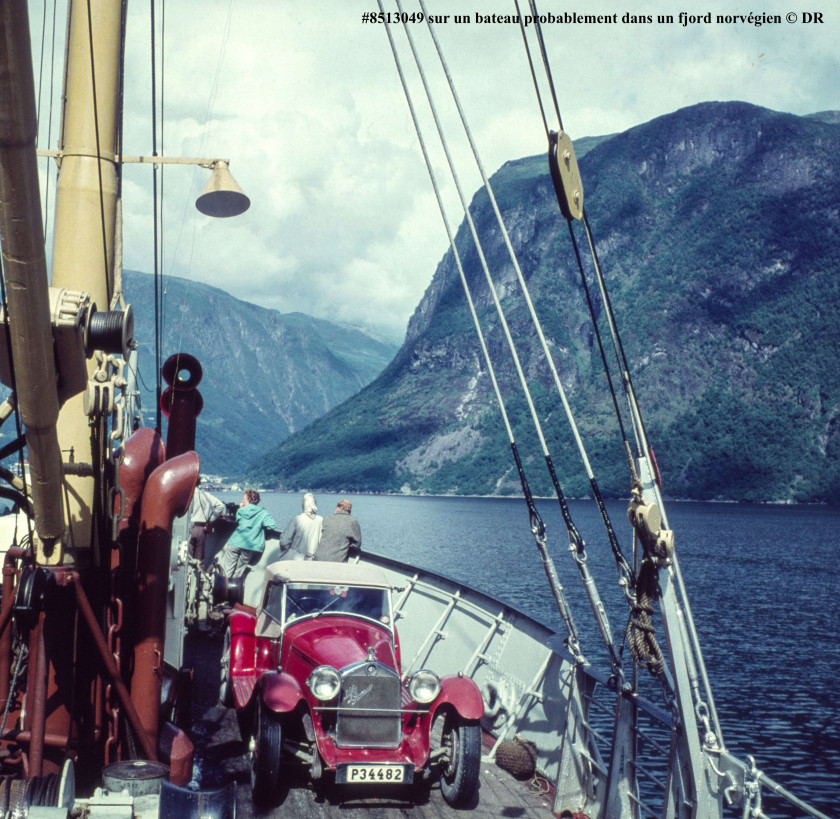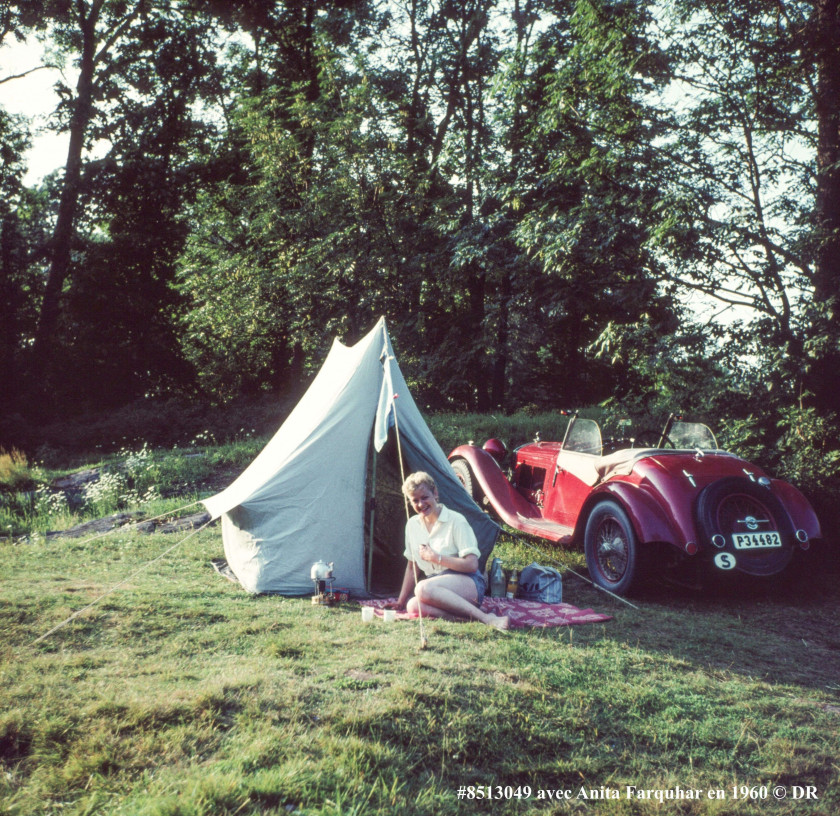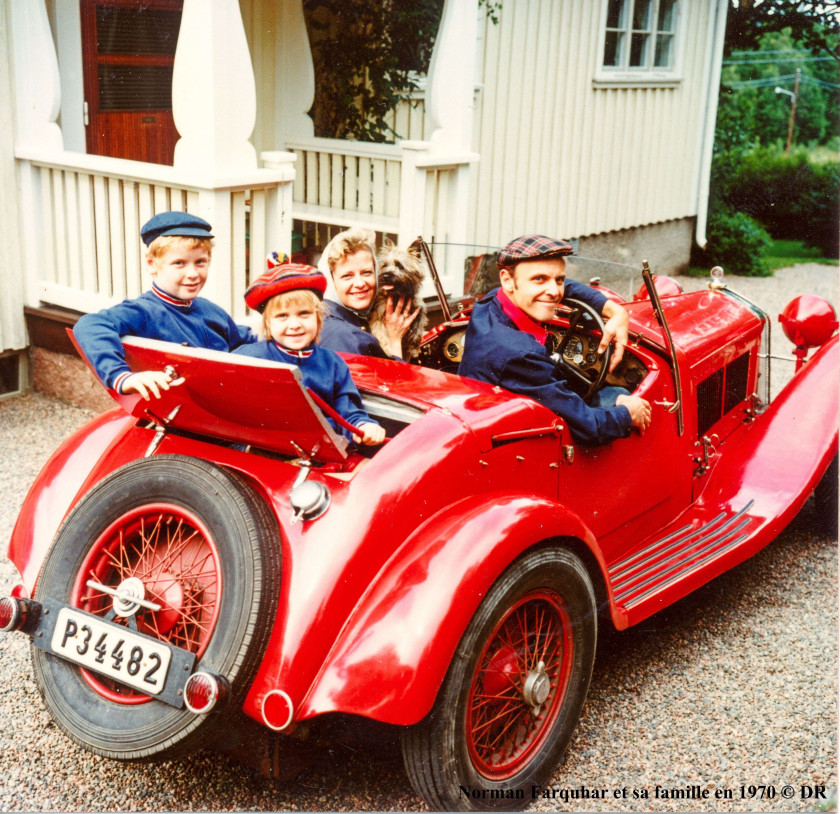Vente Rétromobile 2019 La Vente Officielle - 08 février 2019 /Lot 37 1930 Alfa Romeo 6C 1750 Gran Sport roadster Corsica
1930 Alfa Romeo 6C 1750 Gran Sport roadster Corsica
Titre de circulation suédois
Châssis n° 8513049
Moteur n° 8513049
- Historique exceptionnel
- Dans la famille Farquhar depuis 1953
- Modèle rare et performant
- Mécanique d'origine
- État d'origine sans équivalent
Dans le monde des automobiles anciennes, il y a des voitures restaurées, et des voitures qui ont une histoire. La différence entre les deux, c'est qu'une restauration, il est toujours possible de la réaliser, mais une histoire, cela ne peut pas se recréer. C'est pourquoi il est toujours émouvant de se trouver en face d'une automobile dont le passé peut se lire comme un grand livre d'image.
C'est exactement le cas de cette Alfa Romeo, qui a appartenu à la même famille entre 1953 et aujourd'hui, et qui a accompagné de nombreux voyages et évènements.
Rappelons que l'Alfa Romeo 1750 GS à compresseur faisait partie des voitures de sport les plus brillantes de son époque. Elle était dotée d'un six-cylindres double arbre conçu par Vittorio Jano (inspiré, selon Farquhar, des moteurs Hispano de Marc Birkigt) dont la puissance était de 90 ch environ pour la version à compresseur. Cette famille de modèles s'est distinguée à plusieurs reprises aux Mille Miglia.
Selon Luigi Fusi, spécialiste aussi regretté qu'indiscuté, Alfa Romeo aurait produit 87 châssis du type de celle de la vente en 1930, pour un total de 290 exemplaires de 1930 à 1934. Selon son numéro de châssis, la présente voiture pourrait donc être la 49e produite.
Cette Alfa Romeo 1750 Gran Sport est livrée en Angleterre en 1930 à M. Joseph A.-M. Patrick, demeurant à Kings Norton, près de Birmingham. Arrivée en châssis, nous ne pouvons au moment de l'impression du catalogue confirmer quel carrossier habilla la voiture initialement, même si, M. Farquhar pensait qu'elle avait été réalisée par James Young. Il faut noter que Joseph Patrick tenait alors un garage automobile et un atelier de carrosserie, sous le nom Patrick Motors et il n'est pas exclu qu'il ait fait carrosser la voiture par ses propres ouvriers. Pilote automobile à ses heures, possédant différentes automobiles de sport, il eut après la Gran Sport une 1750 SS. Il a participé avec sa nouvelle acquisition à plusieurs épreuves d'importance. Certaines sources le mentionnent au volant d'une Alfa 1750 notamment dans les courses suivantes :
- 26 septembre 1931, course d'une heure à Brooklands, vainqueur de la "Gold Medal" à la moyenne de 130 km/h.
- 1932, trial de Gloucester & Vessey, victoire.
- Novembre 1933, deuxième de sa catégorie. Le magazine Motorsport indique "Patrick a connu des problèmes avec son Alfa, avec des vitesses qui ont sauté au deuxième virage".
Aujourd'hui, le garage Patrick Motors n'existe plus mais il a laissé place à la "Patrick Collection", un musée basé à Birmingham et abritant les voitures conservées par le garage. Dans ce musée se trouvait une photo de l'Alfa Romeo 1750, immatriculée OV 3264, ce qui correspond bien à un numéro de Birmingham, du début des années 1930 ("OV 1" ayant été délivré en avril 1931 selon Simon Moore). Comme on peut le voir sur la facture d'achat originale, datant du 22 septembre 1953, présente dans le dossier, OV 3264 est le numéro que portait encore cette voiture lorsque Norman Farquhar a décidé de l'acheter pour 400 Livres sterling auprès d'un négociant, Allistair A Cameron basé 6 Portobello Mews, à Londres.
Mais entretemps, selon Norman Farquhar, son deuxième propriétaire avait fait modifier en 1935 la voiture chez Corsica, à Londres, avec une carrosserie biplace légère, dotée d'un petit spider à l'arrière. Elle était constituée d'une structure bois sur laquelle avaient été formés des panneaux d'aluminium, comme il était de coutume à l'époque.
En 1953, elle est pilotée par Tom Barnard lors d'un meeting à Goodwood. Elle est achetée juste après, par Norman Farquhar. Commence alors une deuxième vie qui va nous amener jusqu'à aujourd'hui.
Norman Farquhar est un américain, venant d'une famille écossaise comme son nom l'indique, qui a étudié l'ingénierie mécanique à l'université de Cornell, puis le Design industriel à Saint Martins de Londres où il séjourna quelques années. Lorsqu'il résidait à Göteborg, garant la voiture dans la rue, il découvrit une tentative pour forcer la serrure de l'Alfa Romeo, ce qui l'amena à concevoir un petit système antivol de son crû.
Durant les années 1950, il déménage en Suède où il a rencontré son épouse, il va alors participer activement au développement de la Saab de rallye d'Erik Carlsson et d'autres projets de la marque. En 1958-1959, ses compétences élevées en ingénierie, lui permette de se lancer dans la réfection du moteur et de la boîte de vitesses de son Alfa. A cette occasion, il effectue un dessin des pièces internes de la boîte et rédige de nombreux commentaires et conseils sur l'entretien et le réglage du moteur. Nous disposons d'un carnet de notes passionnant où sont consignées l'ensemble des informations qu'il a recueillies au fil du temps et de ses essais. Il y est question de démultiplication de boîte, de lubrification, de réglages de carburation, de réglages de soupapes, de travaux effectués, le tout accompagné de dessins techniques d'une grande précision. Méticuleux et amoureux de sa voiture, il va la perfectionner et la fiabiliser, par goût personnel, il modifie le dessin des ailes avant. Il a de toute évidence utilisé ses compétences techniques pour entretenir cette voiture, qu'il connaissait sur le bout des doigts.
C'est sans doute ce qui l'a poussé à entreprendre de longs voyages avec son épouse, n'hésitant pas à prendre depuis la Suède la direction du sud pour se rendre à Rotterdam, Paris et Genève aussi bien qu'aux Etats Unis de 1960 à 1964. Le dossier de la voiture est accompagné de photos fascinantes de ces voyages, où l'on voit l'Alfa Romeo sur un bateau sans doute dans un fjord norvégien, devant le Royal Palace à La Haye, ou le château de Chantilly en France, quand ce n'est pas à côté d'une tente de camping. Certaines sont en noir et blanc, d'autres en couleurs un peu passées et, dans les années 1970, la voiture a même été utilisée avec les deux enfants de Norman Farquhar logés dans le spider.
Il est pourtant resté un utilisateur discret et n'a pris part qu'à quelques réunions de véhicules anciens en Suède. Sa 1750 GS a tout de même fait en mai 1999 la couverture de Klöverbladet, le magazine du Club Alfa Romeo suédois.
Ce passé haut en couleur fait une bonne partie du charme de la voiture qui, jamais restaurée mais toujours bien entretenue, en porte la trace. Cette automobile a vécu et ne demande qu'à poursuivre son existence entre des mains qui sauront en apprécier tout l'intérêt. Norman Farquhar s'est éteint en 2013, et c'est aujourd'hui sa famille qui se sépare de la voiture souhaitant qu'un homme aussi passionné que lui la fasse vivre.
Avec sa rareté, son état d'origine remarquable, sa mécanique d'origine et son histoire hors du commun, cette Alfa Romeo 1750 GS fait sans doute partie des plus exceptionnelles de son genre et constitue une opportunité qui ne se présente que très rarement dans la vie d'un collectionneur.
La participation aux enchères pour ce lot est soumise à une procédure d'enregistrement particulière. Si vous souhaitez enchérir sur ce lot, merci de vous rapprocher du bureau des enchères ou du département Motorcars minimum 48 heures avant la vente.
Swedish title
Chassis n° 8513049
Engine n° 8513049
- Exceptional history
- In the Farquhar family since 1953
- Rare and powerful model
- Mechanically original
- Amazingly original condition
In the world of classic cars, there are some that have been restored and some that have a history. The difference between the two is that you can always carry out a restoration, but a history cannot be reproduced. That's why it's a moving experience to be in front of an automobile whose past can be read like an oversized picture book. This is the case with the Alfa Romeo presented here, a car that has belonged to the same family from 1953 to the present day, coming with numerous tales of voyages and adventures.
The supercharged Alfa Romeo 1750 GS was one of the most outstanding sports cars of its day. It had a six-cylinder twin-cam engine designed by Vittorio Jano (inspired, according to Farquhar, by Marc Birkigt's Hispano engines), producing around 90 bhp in the supercharged version. This family of models distinguished itself on many occasions in the Mille Miglia. According to the incontrovertible specialist, the late Luigi Fusi, Alfa Romeo produced 87 chassis in 1930 like the one in the sale, with a total of 290 examples between 1930 and 1934. The chassis number of our example suggests it would have been the 49th built.
The new Alfa Romeo 1750 Gran Sport was sent to England in 1930, delivered to Mr Joseph A.M. Patrick, who lived in Kings Norton, near Birmingham. The car arrived in chassis form and it has not been possible to confirm, at the time of going to print, who was the first coachbuilder, although Mr Farquhar believed it was James Young. It must be noted that Joseph Patrick ran a garage and coachbuilder's workshop, called Patrick Motors, and it is possible that he had the coachwork built by his own workers. A racing driver in his spare time, he owned various sports cars (after the Gransport, he had a 1750 SS), and raced his new acquisition in several major events. Certain sources mention his name as the driver of an Alfa 1750 in, amongst others, the following races:
- 26 September 1931, one hour race at Brooklands, winner of the "Gold Medal" with an average speed of 130 km/h.
- 1932, Gloucester & Vessey trial, winner.
- November 1933, second in class. The magazine Motorsport noted "Patrick had some problems with his Alfa, which jumped out of gear on the second corner".
The Patrick Motors garage no longer exists but it gave way to the "Patrick Collection", a museum based in Birmingham housing cars kept by the garage. There was a photo on display in the museum of the Alfa Romeo 1750, registration OV 3264. In the early 1930s, this would have been a Birmingham number ("OV 1" was delivered in April 1931 according to Simon Moore). As we can see on the original invoice from the 22nd of September 1953 still in the file, OV 3264 was still the registration number of the car when Norman Farquhar decided to buy it for 400 English pounds, from a dealer called Allistair A. Cameron, 6 Portobello mews, based in Noting hill Gate, London. According to Farquar, the car had been modified by the second owner in 1935, and fitted by Corsica, in London, with a lightweight two-seater body. This was in spider form at the rear, built with a wooden structure fitted with aluminium panels, as was customary at the time.
The Alfa was driven by Tom Barnard in a meeting at Goodwood in 1953. Barnard was a real motor-racing personality from west Midlands and further went on as a designer and carbon crafter for McLaren. Bought by Farquhar shortly afterwards its second life began, which has continued to the present day.
Norman Farquhar was American, descended from a Scottish family, as his name suggests. After a degree in mechanical engineering at Cornell University, in the early 1950s he studied industrial design at Saint Martins in London where he stayed for a while. During the 1950s he moved to Sweden where he met his wife. In Gotenbörg, he parked the Alfa Romeo in the street as usual and discovered that someone had tried to force the lock. This encouraged him to invent a small anti-theft device. In the early 1960's he worked for Saab where he was a member of the group designing the rally Saabs for Erik Carlsson. He explained to his son, that several times, one of the design group members had to go with E.Carlsson on test drives to take notes of what he wanted adjusted. All in the team were terrified to go and pulled straw about who should go. Norman Farquhar pulled the short straw a couple of times and said it was incredible.
In 1958-1959, as he had high skills of engineering, he set about rebuilding the engine and gearbox of his Alfa. To this end, he made a drawing of the internal parts of the gearbox and wrote extensive notes with advice on the maintenance and refinement of the engine.
We have a fascinating notebook filled with information he collected over the years and various tests he carried out. There is discussion of gear ratios, lubrication, adjustment of the carburettors and the valves, of work he undertook, all accompanied by incredibly precise technical drawings. Meticulous and passionate about his car, he worked tirelessly to improve it and make it more reliable. For reasons of personal taste, he also modified the design of the front wings. Farquhar clearly drew on his engineering skills to maintain the car that he knew inside out.
This was undoubtedly why he felt confident in undertaking long journeys with his wife, setting off without hesitation from Sweden and travelling to Rotterdam, Paris and Geneva. he actually also brought the car over to the U.S. in 1960 and back to Sweden in 1964. The file with the car contains many extraordinary photos of these trips, showing the Alfa Romeo on a boat in the Norwegian fjords, in front of the Royal Palace at The Hague, and the Château de Chantilly in France, as well as next to their camping tent. Some are in black and white, others in faded colour and there are photos taken during the 1970's showing Farquhar's two children squeezed into the rear spider.
He remained discreet in his use of the Alfa and only took part in a few old car meetings in Sweden. In May 1999, it did, however, feature on the cover of Klöverbladet, the Swedish Alfa Romeo Club magazine. It is a car full of charm, displaying its colourful past with pride, having never been restored and always well maintained. This automobile has lived life to the full and is now looking for a new owner to appreciate this. Norman Farquhar died in 2013 and it is his family who are parting with the car, hoping that someone as passionate as him will take it on.
Being rare, in remarkably original condition, complete with its original engine and a special history, this Alfa Romeo 1750 GS must be one of the most exceptional examples of its type. It offers an opportunity that rarely arises in the life of a collector.
Participating in the auction on this lot is subject to a special registration process. If you would like to bid on this lot, please get in touch with the bidding office or the motorcars department at least 48 hours before the sale.
Estimation 900 000 - 1 400 000 €
Vendu 977 440 €
* Les résultats sont affichés frais acheteur et taxes compris. Ils sont générés automatiquement et peuvent subir des modifications.
Titre de circulation suédois
Châssis n° 8513049
Moteur n° 8513049
- Historique exceptionnel
- Dans la famille Farquhar depuis 1953
- Modèle rare et performant
- Mécanique d'origine
- État d'origine sans équivalent
Dans le monde des automobiles anciennes, il y a des voitures restaurées, et des voitures qui ont une histoire. La différence entre les deux, c'est qu'une restauration, il est toujours possible de la réaliser, mais une histoire, cela ne peut pas se recréer. C'est pourquoi il est toujours émouvant de se trouver en face d'une automobile dont le passé peut se lire comme un grand livre d'image.
C'est exactement le cas de cette Alfa Romeo, qui a appartenu à la même famille entre 1953 et aujourd'hui, et qui a accompagné de nombreux voyages et évènements.
Rappelons que l'Alfa Romeo 1750 GS à compresseur faisait partie des voitures de sport les plus brillantes de son époque. Elle était dotée d'un six-cylindres double arbre conçu par Vittorio Jano (inspiré, selon Farquhar, des moteurs Hispano de Marc Birkigt) dont la puissance était de 90 ch environ pour la version à compresseur. Cette famille de modèles s'est distinguée à plusieurs reprises aux Mille Miglia.
Selon Luigi Fusi, spécialiste aussi regretté qu'indiscuté, Alfa Romeo aurait produit 87 châssis du type de celle de la vente en 1930, pour un total de 290 exemplaires de 1930 à 1934. Selon son numéro de châssis, la présente voiture pourrait donc être la 49e produite.
Cette Alfa Romeo 1750 Gran Sport est livrée en Angleterre en 1930 à M. Joseph A.-M. Patrick, demeurant à Kings Norton, près de Birmingham. Arrivée en châssis, nous ne pouvons au moment de l'impression du catalogue confirmer quel carrossier habilla la voiture initialement, même si, M. Farquhar pensait qu'elle avait été réalisée par James Young. Il faut noter que Joseph Patrick tenait alors un garage automobile et un atelier de carrosserie, sous le nom Patrick Motors et il n'est pas exclu qu'il ait fait carrosser la voiture par ses propres ouvriers. Pilote automobile à ses heures, possédant différentes automobiles de sport, il eut après la Gran Sport une 1750 SS. Il a participé avec sa nouvelle acquisition à plusieurs épreuves d'importance. Certaines sources le mentionnent au volant d'une Alfa 1750 notamment dans les courses suivantes :
- 26 septembre 1931, course d'une heure à Brooklands, vainqueur de la "Gold Medal" à la moyenne de 130 km/h.
- 1932, trial de Gloucester & Vessey, victoire.
- Novembre 1933, deuxième de sa catégorie. Le magazine Motorsport indique "Patrick a connu des problèmes avec son Alfa, avec des vitesses qui ont sauté au deuxième virage".
Aujourd'hui, le garage Patrick Motors n'existe plus mais il a laissé place à la "Patrick Collection", un musée basé à Birmingham et abritant les voitures conservées par le garage. Dans ce musée se trouvait une photo de l'Alfa Romeo 1750, immatriculée OV 3264, ce qui correspond bien à un numéro de Birmingham, du début des années 1930 ("OV 1" ayant été délivré en avril 1931 selon Simon Moore). Comme on peut le voir sur la facture d'achat originale, datant du 22 septembre 1953, présente dans le dossier, OV 3264 est le numéro que portait encore cette voiture lorsque Norman Farquhar a décidé de l'acheter pour 400 Livres sterling auprès d'un négociant, Allistair A Cameron basé 6 Portobello Mews, à Londres.
Mais entretemps, selon Norman Farquhar, son deuxième propriétaire avait fait modifier en 1935 la voiture chez Corsica, à Londres, avec une carrosserie biplace légère, dotée d'un petit spider à l'arrière. Elle était constituée d'une structure bois sur laquelle avaient été formés des panneaux d'aluminium, comme il était de coutume à l'époque.
En 1953, elle est pilotée par Tom Barnard lors d'un meeting à Goodwood. Elle est achetée juste après, par Norman Farquhar. Commence alors une deuxième vie qui va nous amener jusqu'à aujourd'hui.
Norman Farquhar est un américain, venant d'une famille écossaise comme son nom l'indique, qui a étudié l'ingénierie mécanique à l'université de Cornell, puis le Design industriel à Saint Martins de Londres où il séjourna quelques années. Lorsqu'il résidait à Göteborg, garant la voiture dans la rue, il découvrit une tentative pour forcer la serrure de l'Alfa Romeo, ce qui l'amena à concevoir un petit système antivol de son crû.
Durant les années 1950, il déménage en Suède où il a rencontré son épouse, il va alors participer activement au développement de la Saab de rallye d'Erik Carlsson et d'autres projets de la marque. En 1958-1959, ses compétences élevées en ingénierie, lui permette de se lancer dans la réfection du moteur et de la boîte de vitesses de son Alfa. A cette occasion, il effectue un dessin des pièces internes de la boîte et rédige de nombreux commentaires et conseils sur l'entretien et le réglage du moteur. Nous disposons d'un carnet de notes passionnant où sont consignées l'ensemble des informations qu'il a recueillies au fil du temps et de ses essais. Il y est question de démultiplication de boîte, de lubrification, de réglages de carburation, de réglages de soupapes, de travaux effectués, le tout accompagné de dessins techniques d'une grande précision. Méticuleux et amoureux de sa voiture, il va la perfectionner et la fiabiliser, par goût personnel, il modifie le dessin des ailes avant. Il a de toute évidence utilisé ses compétences techniques pour entretenir cette voiture, qu'il connaissait sur le bout des doigts.
C'est sans doute ce qui l'a poussé à entreprendre de longs voyages avec son épouse, n'hésitant pas à prendre depuis la Suède la direction du sud pour se rendre à Rotterdam, Paris et Genève aussi bien qu'aux Etats Unis de 1960 à 1964. Le dossier de la voiture est accompagné de photos fascinantes de ces voyages, où l'on voit l'Alfa Romeo sur un bateau sans doute dans un fjord norvégien, devant le Royal Palace à La Haye, ou le château de Chantilly en France, quand ce n'est pas à côté d'une tente de camping. Certaines sont en noir et blanc, d'autres en couleurs un peu passées et, dans les années 1970, la voiture a même été utilisée avec les deux enfants de Norman Farquhar logés dans le spider.
Il est pourtant resté un utilisateur discret et n'a pris part qu'à quelques réunions de véhicules anciens en Suède. Sa 1750 GS a tout de même fait en mai 1999 la couverture de Klöverbladet, le magazine du Club Alfa Romeo suédois.
Ce passé haut en couleur fait une bonne partie du charme de la voiture qui, jamais restaurée mais toujours bien entretenue, en porte la trace. Cette automobile a vécu et ne demande qu'à poursuivre son existence entre des mains qui sauront en apprécier tout l'intérêt. Norman Farquhar s'est éteint en 2013, et c'est aujourd'hui sa famille qui se sépare de la voiture souhaitant qu'un homme aussi passionné que lui la fasse vivre.
Avec sa rareté, son état d'origine remarquable, sa mécanique d'origine et son histoire hors du commun, cette Alfa Romeo 1750 GS fait sans doute partie des plus exceptionnelles de son genre et constitue une opportunité qui ne se présente que très rarement dans la vie d'un collectionneur.
La participation aux enchères pour ce lot est soumise à une procédure d'enregistrement particulière. Si vous souhaitez enchérir sur ce lot, merci de vous rapprocher du bureau des enchères ou du département Motorcars minimum 48 heures avant la vente.
Swedish title
Chassis n° 8513049
Engine n° 8513049
- Exceptional history
- In the Farquhar family since 1953
- Rare and powerful model
- Mechanically original
- Amazingly original condition
In the world of classic cars, there are some that have been restored and some that have a history. The difference between the two is that you can always carry out a restoration, but a history cannot be reproduced. That's why it's a moving experience to be in front of an automobile whose past can be read like an oversized picture book. This is the case with the Alfa Romeo presented here, a car that has belonged to the same family from 1953 to the present day, coming with numerous tales of voyages and adventures.
The supercharged Alfa Romeo 1750 GS was one of the most outstanding sports cars of its day. It had a six-cylinder twin-cam engine designed by Vittorio Jano (inspired, according to Farquhar, by Marc Birkigt's Hispano engines), producing around 90 bhp in the supercharged version. This family of models distinguished itself on many occasions in the Mille Miglia. According to the incontrovertible specialist, the late Luigi Fusi, Alfa Romeo produced 87 chassis in 1930 like the one in the sale, with a total of 290 examples between 1930 and 1934. The chassis number of our example suggests it would have been the 49th built.
The new Alfa Romeo 1750 Gran Sport was sent to England in 1930, delivered to Mr Joseph A.M. Patrick, who lived in Kings Norton, near Birmingham. The car arrived in chassis form and it has not been possible to confirm, at the time of going to print, who was the first coachbuilder, although Mr Farquhar believed it was James Young. It must be noted that Joseph Patrick ran a garage and coachbuilder's workshop, called Patrick Motors, and it is possible that he had the coachwork built by his own workers. A racing driver in his spare time, he owned various sports cars (after the Gransport, he had a 1750 SS), and raced his new acquisition in several major events. Certain sources mention his name as the driver of an Alfa 1750 in, amongst others, the following races:
- 26 September 1931, one hour race at Brooklands, winner of the "Gold Medal" with an average speed of 130 km/h.
- 1932, Gloucester & Vessey trial, winner.
- November 1933, second in class. The magazine Motorsport noted "Patrick had some problems with his Alfa, which jumped out of gear on the second corner".
The Patrick Motors garage no longer exists but it gave way to the "Patrick Collection", a museum based in Birmingham housing cars kept by the garage. There was a photo on display in the museum of the Alfa Romeo 1750, registration OV 3264. In the early 1930s, this would have been a Birmingham number ("OV 1" was delivered in April 1931 according to Simon Moore). As we can see on the original invoice from the 22nd of September 1953 still in the file, OV 3264 was still the registration number of the car when Norman Farquhar decided to buy it for 400 English pounds, from a dealer called Allistair A. Cameron, 6 Portobello mews, based in Noting hill Gate, London. According to Farquar, the car had been modified by the second owner in 1935, and fitted by Corsica, in London, with a lightweight two-seater body. This was in spider form at the rear, built with a wooden structure fitted with aluminium panels, as was customary at the time.
The Alfa was driven by Tom Barnard in a meeting at Goodwood in 1953. Barnard was a real motor-racing personality from west Midlands and further went on as a designer and carbon crafter for McLaren. Bought by Farquhar shortly afterwards its second life began, which has continued to the present day.
Norman Farquhar was American, descended from a Scottish family, as his name suggests. After a degree in mechanical engineering at Cornell University, in the early 1950s he studied industrial design at Saint Martins in London where he stayed for a while. During the 1950s he moved to Sweden where he met his wife. In Gotenbörg, he parked the Alfa Romeo in the street as usual and discovered that someone had tried to force the lock. This encouraged him to invent a small anti-theft device. In the early 1960's he worked for Saab where he was a member of the group designing the rally Saabs for Erik Carlsson. He explained to his son, that several times, one of the design group members had to go with E.Carlsson on test drives to take notes of what he wanted adjusted. All in the team were terrified to go and pulled straw about who should go. Norman Farquhar pulled the short straw a couple of times and said it was incredible.
In 1958-1959, as he had high skills of engineering, he set about rebuilding the engine and gearbox of his Alfa. To this end, he made a drawing of the internal parts of the gearbox and wrote extensive notes with advice on the maintenance and refinement of the engine.
We have a fascinating notebook filled with information he collected over the years and various tests he carried out. There is discussion of gear ratios, lubrication, adjustment of the carburettors and the valves, of work he undertook, all accompanied by incredibly precise technical drawings. Meticulous and passionate about his car, he worked tirelessly to improve it and make it more reliable. For reasons of personal taste, he also modified the design of the front wings. Farquhar clearly drew on his engineering skills to maintain the car that he knew inside out.
This was undoubtedly why he felt confident in undertaking long journeys with his wife, setting off without hesitation from Sweden and travelling to Rotterdam, Paris and Geneva. he actually also brought the car over to the U.S. in 1960 and back to Sweden in 1964. The file with the car contains many extraordinary photos of these trips, showing the Alfa Romeo on a boat in the Norwegian fjords, in front of the Royal Palace at The Hague, and the Château de Chantilly in France, as well as next to their camping tent. Some are in black and white, others in faded colour and there are photos taken during the 1970's showing Farquhar's two children squeezed into the rear spider.
He remained discreet in his use of the Alfa and only took part in a few old car meetings in Sweden. In May 1999, it did, however, feature on the cover of Klöverbladet, the Swedish Alfa Romeo Club magazine. It is a car full of charm, displaying its colourful past with pride, having never been restored and always well maintained. This automobile has lived life to the full and is now looking for a new owner to appreciate this. Norman Farquhar died in 2013 and it is his family who are parting with the car, hoping that someone as passionate as him will take it on.
Being rare, in remarkably original condition, complete with its original engine and a special history, this Alfa Romeo 1750 GS must be one of the most exceptional examples of its type. It offers an opportunity that rarely arises in the life of a collector.
Participating in the auction on this lot is subject to a special registration process. If you would like to bid on this lot, please get in touch with the bidding office or the motorcars department at least 48 hours before the sale.
Estimation 900 000 - 1 400 000 €
Vendu 977 440 €
* Les résultats sont affichés frais acheteur et taxes compris. Ils sont générés automatiquement et peuvent subir des modifications.
Lot 37
1930 Alfa Romeo 6C 1750 Gran Sport roadster Corsica
Lot 37
Vendu 977 440 € [$]
1930 Alfa Romeo 6C 1750 Gran Sport roadster Corsica
Titre de circulation suédois
Châssis n° 8513049
Moteur n° 8513049
- Historique exceptionnel
- Dans la famille Farquhar depuis 1953
- Modèle rare et performant
- Mécanique d'origine
- État d'origine sans équivalent
Dans le monde des automobiles anciennes, il y a des voitures restaurées, et des voitures qui ont une histoire. La différence entre les deux, c'est qu'une restauration, il est toujours possible de la réaliser, mais une histoire, cela ne peut pas se recréer. C'est pourquoi il est toujours émouvant de se trouver en face d'une automobile dont le passé peut se lire comme un grand livre d'image.
C'est exactement le cas de cette Alfa Romeo, qui a appartenu à la même famille entre 1953 et aujourd'hui, et qui a accompagné de nombreux voyages et évènements.
Rappelons que l'Alfa Romeo 1750 GS à compresseur faisait partie des voitures de sport les plus brillantes de son époque. Elle était dotée d'un six-cylindres double arbre conçu par Vittorio Jano (inspiré, selon Farquhar, des moteurs Hispano de Marc Birkigt) dont la puissance était de 90 ch environ pour la version à compresseur. Cette famille de modèles s'est distinguée à plusieurs reprises aux Mille Miglia.
Selon Luigi Fusi, spécialiste aussi regretté qu'indiscuté, Alfa Romeo aurait produit 87 châssis du type de celle de la vente en 1930, pour un total de 290 exemplaires de 1930 à 1934. Selon son numéro de châssis, la présente voiture pourrait donc être la 49e produite.
Cette Alfa Romeo 1750 Gran Sport est livrée en Angleterre en 1930 à M. Joseph A.-M. Patrick, demeurant à Kings Norton, près de Birmingham. Arrivée en châssis, nous ne pouvons au moment de l'impression du catalogue confirmer quel carrossier habilla la voiture initialement, même si, M. Farquhar pensait qu'elle avait été réalisée par James Young. Il faut noter que Joseph Patrick tenait alors un garage automobile et un atelier de carrosserie, sous le nom Patrick Motors et il n'est pas exclu qu'il ait fait carrosser la voiture par ses propres ouvriers. Pilote automobile à ses heures, possédant différentes automobiles de sport, il eut après la Gran Sport une 1750 SS. Il a participé avec sa nouvelle acquisition à plusieurs épreuves d'importance. Certaines sources le mentionnent au volant d'une Alfa 1750 notamment dans les courses suivantes :
- 26 septembre 1931, course d'une heure à Brooklands, vainqueur de la "Gold Medal" à la moyenne de 130 km/h.
- 1932, trial de Gloucester & Vessey, victoire.
- Novembre 1933, deuxième de sa catégorie. Le magazine Motorsport indique "Patrick a connu des problèmes avec son Alfa, avec des vitesses qui ont sauté au deuxième virage".
Aujourd'hui, le garage Patrick Motors n'existe plus mais il a laissé place à la "Patrick Collection", un musée basé à Birmingham et abritant les voitures conservées par le garage. Dans ce musée se trouvait une photo de l'Alfa Romeo 1750, immatriculée OV 3264, ce qui correspond bien à un numéro de Birmingham, du début des années 1930 ("OV 1" ayant été délivré en avril 1931 selon Simon Moore). Comme on peut le voir sur la facture d'achat originale, datant du 22 septembre 1953, présente dans le dossier, OV 3264 est le numéro que portait encore cette voiture lorsque Norman Farquhar a décidé de l'acheter pour 400 Livres sterling auprès d'un négociant, Allistair A Cameron basé 6 Portobello Mews, à Londres.
Mais entretemps, selon Norman Farquhar, son deuxième propriétaire avait fait modifier en 1935 la voiture chez Corsica, à Londres, avec une carrosserie biplace légère, dotée d'un petit spider à l'arrière. Elle était constituée d'une structure bois sur laquelle avaient été formés des panneaux d'aluminium, comme il était de coutume à l'époque.
En 1953, elle est pilotée par Tom Barnard lors d'un meeting à Goodwood. Elle est achetée juste après, par Norman Farquhar. Commence alors une deuxième vie qui va nous amener jusqu'à aujourd'hui.
Norman Farquhar est un américain, venant d'une famille écossaise comme son nom l'indique, qui a étudié l'ingénierie mécanique à l'université de Cornell, puis le Design industriel à Saint Martins de Londres où il séjourna quelques années. Lorsqu'il résidait à Göteborg, garant la voiture dans la rue, il découvrit une tentative pour forcer la serrure de l'Alfa Romeo, ce qui l'amena à concevoir un petit système antivol de son crû.
Durant les années 1950, il déménage en Suède où il a rencontré son épouse, il va alors participer activement au développement de la Saab de rallye d'Erik Carlsson et d'autres projets de la marque. En 1958-1959, ses compétences élevées en ingénierie, lui permette de se lancer dans la réfection du moteur et de la boîte de vitesses de son Alfa. A cette occasion, il effectue un dessin des pièces internes de la boîte et rédige de nombreux commentaires et conseils sur l'entretien et le réglage du moteur. Nous disposons d'un carnet de notes passionnant où sont consignées l'ensemble des informations qu'il a recueillies au fil du temps et de ses essais. Il y est question de démultiplication de boîte, de lubrification, de réglages de carburation, de réglages de soupapes, de travaux effectués, le tout accompagné de dessins techniques d'une grande précision. Méticuleux et amoureux de sa voiture, il va la perfectionner et la fiabiliser, par goût personnel, il modifie le dessin des ailes avant. Il a de toute évidence utilisé ses compétences techniques pour entretenir cette voiture, qu'il connaissait sur le bout des doigts.
C'est sans doute ce qui l'a poussé à entreprendre de longs voyages avec son épouse, n'hésitant pas à prendre depuis la Suède la direction du sud pour se rendre à Rotterdam, Paris et Genève aussi bien qu'aux Etats Unis de 1960 à 1964. Le dossier de la voiture est accompagné de photos fascinantes de ces voyages, où l'on voit l'Alfa Romeo sur un bateau sans doute dans un fjord norvégien, devant le Royal Palace à La Haye, ou le château de Chantilly en France, quand ce n'est pas à côté d'une tente de camping. Certaines sont en noir et blanc, d'autres en couleurs un peu passées et, dans les années 1970, la voiture a même été utilisée avec les deux enfants de Norman Farquhar logés dans le spider.
Il est pourtant resté un utilisateur discret et n'a pris part qu'à quelques réunions de véhicules anciens en Suède. Sa 1750 GS a tout de même fait en mai 1999 la couverture de Klöverbladet, le magazine du Club Alfa Romeo suédois.
Ce passé haut en couleur fait une bonne partie du charme de la voiture qui, jamais restaurée mais toujours bien entretenue, en porte la trace. Cette automobile a vécu et ne demande qu'à poursuivre son existence entre des mains qui sauront en apprécier tout l'intérêt. Norman Farquhar s'est éteint en 2013, et c'est aujourd'hui sa famille qui se sépare de la voiture souhaitant qu'un homme aussi passionné que lui la fasse vivre.
Avec sa rareté, son état d'origine remarquable, sa mécanique d'origine et son histoire hors du commun, cette Alfa Romeo 1750 GS fait sans doute partie des plus exceptionnelles de son genre et constitue une opportunité qui ne se présente que très rarement dans la vie d'un collectionneur.
La participation aux enchères pour ce lot est soumise à une procédure d'enregistrement particulière. Si vous souhaitez enchérir sur ce lot, merci de vous rapprocher du bureau des enchères ou du département Motorcars minimum 48 heures avant la vente.
Swedish title
Chassis n° 8513049
Engine n° 8513049
- Exceptional history
- In the Farquhar family since 1953
- Rare and powerful model
- Mechanically original
- Amazingly original condition
In the world of classic cars, there are some that have been restored and some that have a history. The difference between the two is that you can always carry out a restoration, but a history cannot be reproduced. That's why it's a moving experience to be in front of an automobile whose past can be read like an oversized picture book. This is the case with the Alfa Romeo presented here, a car that has belonged to the same family from 1953 to the present day, coming with numerous tales of voyages and adventures.
The supercharged Alfa Romeo 1750 GS was one of the most outstanding sports cars of its day. It had a six-cylinder twin-cam engine designed by Vittorio Jano (inspired, according to Farquhar, by Marc Birkigt's Hispano engines), producing around 90 bhp in the supercharged version. This family of models distinguished itself on many occasions in the Mille Miglia. According to the incontrovertible specialist, the late Luigi Fusi, Alfa Romeo produced 87 chassis in 1930 like the one in the sale, with a total of 290 examples between 1930 and 1934. The chassis number of our example suggests it would have been the 49th built.
The new Alfa Romeo 1750 Gran Sport was sent to England in 1930, delivered to Mr Joseph A.M. Patrick, who lived in Kings Norton, near Birmingham. The car arrived in chassis form and it has not been possible to confirm, at the time of going to print, who was the first coachbuilder, although Mr Farquhar believed it was James Young. It must be noted that Joseph Patrick ran a garage and coachbuilder's workshop, called Patrick Motors, and it is possible that he had the coachwork built by his own workers. A racing driver in his spare time, he owned various sports cars (after the Gransport, he had a 1750 SS), and raced his new acquisition in several major events. Certain sources mention his name as the driver of an Alfa 1750 in, amongst others, the following races:
- 26 September 1931, one hour race at Brooklands, winner of the "Gold Medal" with an average speed of 130 km/h.
- 1932, Gloucester & Vessey trial, winner.
- November 1933, second in class. The magazine Motorsport noted "Patrick had some problems with his Alfa, which jumped out of gear on the second corner".
The Patrick Motors garage no longer exists but it gave way to the "Patrick Collection", a museum based in Birmingham housing cars kept by the garage. There was a photo on display in the museum of the Alfa Romeo 1750, registration OV 3264. In the early 1930s, this would have been a Birmingham number ("OV 1" was delivered in April 1931 according to Simon Moore). As we can see on the original invoice from the 22nd of September 1953 still in the file, OV 3264 was still the registration number of the car when Norman Farquhar decided to buy it for 400 English pounds, from a dealer called Allistair A. Cameron, 6 Portobello mews, based in Noting hill Gate, London. According to Farquar, the car had been modified by the second owner in 1935, and fitted by Corsica, in London, with a lightweight two-seater body. This was in spider form at the rear, built with a wooden structure fitted with aluminium panels, as was customary at the time.
The Alfa was driven by Tom Barnard in a meeting at Goodwood in 1953. Barnard was a real motor-racing personality from west Midlands and further went on as a designer and carbon crafter for McLaren. Bought by Farquhar shortly afterwards its second life began, which has continued to the present day.
Norman Farquhar was American, descended from a Scottish family, as his name suggests. After a degree in mechanical engineering at Cornell University, in the early 1950s he studied industrial design at Saint Martins in London where he stayed for a while. During the 1950s he moved to Sweden where he met his wife. In Gotenbörg, he parked the Alfa Romeo in the street as usual and discovered that someone had tried to force the lock. This encouraged him to invent a small anti-theft device. In the early 1960's he worked for Saab where he was a member of the group designing the rally Saabs for Erik Carlsson. He explained to his son, that several times, one of the design group members had to go with E.Carlsson on test drives to take notes of what he wanted adjusted. All in the team were terrified to go and pulled straw about who should go. Norman Farquhar pulled the short straw a couple of times and said it was incredible.
In 1958-1959, as he had high skills of engineering, he set about rebuilding the engine and gearbox of his Alfa. To this end, he made a drawing of the internal parts of the gearbox and wrote extensive notes with advice on the maintenance and refinement of the engine.
We have a fascinating notebook filled with information he collected over the years and various tests he carried out. There is discussion of gear ratios, lubrication, adjustment of the carburettors and the valves, of work he undertook, all accompanied by incredibly precise technical drawings. Meticulous and passionate about his car, he worked tirelessly to improve it and make it more reliable. For reasons of personal taste, he also modified the design of the front wings. Farquhar clearly drew on his engineering skills to maintain the car that he knew inside out.
This was undoubtedly why he felt confident in undertaking long journeys with his wife, setting off without hesitation from Sweden and travelling to Rotterdam, Paris and Geneva. he actually also brought the car over to the U.S. in 1960 and back to Sweden in 1964. The file with the car contains many extraordinary photos of these trips, showing the Alfa Romeo on a boat in the Norwegian fjords, in front of the Royal Palace at The Hague, and the Château de Chantilly in France, as well as next to their camping tent. Some are in black and white, others in faded colour and there are photos taken during the 1970's showing Farquhar's two children squeezed into the rear spider.
He remained discreet in his use of the Alfa and only took part in a few old car meetings in Sweden. In May 1999, it did, however, feature on the cover of Klöverbladet, the Swedish Alfa Romeo Club magazine. It is a car full of charm, displaying its colourful past with pride, having never been restored and always well maintained. This automobile has lived life to the full and is now looking for a new owner to appreciate this. Norman Farquhar died in 2013 and it is his family who are parting with the car, hoping that someone as passionate as him will take it on.
Being rare, in remarkably original condition, complete with its original engine and a special history, this Alfa Romeo 1750 GS must be one of the most exceptional examples of its type. It offers an opportunity that rarely arises in the life of a collector.
Participating in the auction on this lot is subject to a special registration process. If you would like to bid on this lot, please get in touch with the bidding office or the motorcars department at least 48 hours before the sale.
Estimation 900 000 - 1 400 000 €
Vendu 977 440 €
* Les résultats sont affichés frais acheteur et taxes compris. Ils sont générés automatiquement et peuvent subir des modifications.
Titre de circulation suédois
Châssis n° 8513049
Moteur n° 8513049
- Historique exceptionnel
- Dans la famille Farquhar depuis 1953
- Modèle rare et performant
- Mécanique d'origine
- État d'origine sans équivalent
Dans le monde des automobiles anciennes, il y a des voitures restaurées, et des voitures qui ont une histoire. La différence entre les deux, c'est qu'une restauration, il est toujours possible de la réaliser, mais une histoire, cela ne peut pas se recréer. C'est pourquoi il est toujours émouvant de se trouver en face d'une automobile dont le passé peut se lire comme un grand livre d'image.
C'est exactement le cas de cette Alfa Romeo, qui a appartenu à la même famille entre 1953 et aujourd'hui, et qui a accompagné de nombreux voyages et évènements.
Rappelons que l'Alfa Romeo 1750 GS à compresseur faisait partie des voitures de sport les plus brillantes de son époque. Elle était dotée d'un six-cylindres double arbre conçu par Vittorio Jano (inspiré, selon Farquhar, des moteurs Hispano de Marc Birkigt) dont la puissance était de 90 ch environ pour la version à compresseur. Cette famille de modèles s'est distinguée à plusieurs reprises aux Mille Miglia.
Selon Luigi Fusi, spécialiste aussi regretté qu'indiscuté, Alfa Romeo aurait produit 87 châssis du type de celle de la vente en 1930, pour un total de 290 exemplaires de 1930 à 1934. Selon son numéro de châssis, la présente voiture pourrait donc être la 49e produite.
Cette Alfa Romeo 1750 Gran Sport est livrée en Angleterre en 1930 à M. Joseph A.-M. Patrick, demeurant à Kings Norton, près de Birmingham. Arrivée en châssis, nous ne pouvons au moment de l'impression du catalogue confirmer quel carrossier habilla la voiture initialement, même si, M. Farquhar pensait qu'elle avait été réalisée par James Young. Il faut noter que Joseph Patrick tenait alors un garage automobile et un atelier de carrosserie, sous le nom Patrick Motors et il n'est pas exclu qu'il ait fait carrosser la voiture par ses propres ouvriers. Pilote automobile à ses heures, possédant différentes automobiles de sport, il eut après la Gran Sport une 1750 SS. Il a participé avec sa nouvelle acquisition à plusieurs épreuves d'importance. Certaines sources le mentionnent au volant d'une Alfa 1750 notamment dans les courses suivantes :
- 26 septembre 1931, course d'une heure à Brooklands, vainqueur de la "Gold Medal" à la moyenne de 130 km/h.
- 1932, trial de Gloucester & Vessey, victoire.
- Novembre 1933, deuxième de sa catégorie. Le magazine Motorsport indique "Patrick a connu des problèmes avec son Alfa, avec des vitesses qui ont sauté au deuxième virage".
Aujourd'hui, le garage Patrick Motors n'existe plus mais il a laissé place à la "Patrick Collection", un musée basé à Birmingham et abritant les voitures conservées par le garage. Dans ce musée se trouvait une photo de l'Alfa Romeo 1750, immatriculée OV 3264, ce qui correspond bien à un numéro de Birmingham, du début des années 1930 ("OV 1" ayant été délivré en avril 1931 selon Simon Moore). Comme on peut le voir sur la facture d'achat originale, datant du 22 septembre 1953, présente dans le dossier, OV 3264 est le numéro que portait encore cette voiture lorsque Norman Farquhar a décidé de l'acheter pour 400 Livres sterling auprès d'un négociant, Allistair A Cameron basé 6 Portobello Mews, à Londres.
Mais entretemps, selon Norman Farquhar, son deuxième propriétaire avait fait modifier en 1935 la voiture chez Corsica, à Londres, avec une carrosserie biplace légère, dotée d'un petit spider à l'arrière. Elle était constituée d'une structure bois sur laquelle avaient été formés des panneaux d'aluminium, comme il était de coutume à l'époque.
En 1953, elle est pilotée par Tom Barnard lors d'un meeting à Goodwood. Elle est achetée juste après, par Norman Farquhar. Commence alors une deuxième vie qui va nous amener jusqu'à aujourd'hui.
Norman Farquhar est un américain, venant d'une famille écossaise comme son nom l'indique, qui a étudié l'ingénierie mécanique à l'université de Cornell, puis le Design industriel à Saint Martins de Londres où il séjourna quelques années. Lorsqu'il résidait à Göteborg, garant la voiture dans la rue, il découvrit une tentative pour forcer la serrure de l'Alfa Romeo, ce qui l'amena à concevoir un petit système antivol de son crû.
Durant les années 1950, il déménage en Suède où il a rencontré son épouse, il va alors participer activement au développement de la Saab de rallye d'Erik Carlsson et d'autres projets de la marque. En 1958-1959, ses compétences élevées en ingénierie, lui permette de se lancer dans la réfection du moteur et de la boîte de vitesses de son Alfa. A cette occasion, il effectue un dessin des pièces internes de la boîte et rédige de nombreux commentaires et conseils sur l'entretien et le réglage du moteur. Nous disposons d'un carnet de notes passionnant où sont consignées l'ensemble des informations qu'il a recueillies au fil du temps et de ses essais. Il y est question de démultiplication de boîte, de lubrification, de réglages de carburation, de réglages de soupapes, de travaux effectués, le tout accompagné de dessins techniques d'une grande précision. Méticuleux et amoureux de sa voiture, il va la perfectionner et la fiabiliser, par goût personnel, il modifie le dessin des ailes avant. Il a de toute évidence utilisé ses compétences techniques pour entretenir cette voiture, qu'il connaissait sur le bout des doigts.
C'est sans doute ce qui l'a poussé à entreprendre de longs voyages avec son épouse, n'hésitant pas à prendre depuis la Suède la direction du sud pour se rendre à Rotterdam, Paris et Genève aussi bien qu'aux Etats Unis de 1960 à 1964. Le dossier de la voiture est accompagné de photos fascinantes de ces voyages, où l'on voit l'Alfa Romeo sur un bateau sans doute dans un fjord norvégien, devant le Royal Palace à La Haye, ou le château de Chantilly en France, quand ce n'est pas à côté d'une tente de camping. Certaines sont en noir et blanc, d'autres en couleurs un peu passées et, dans les années 1970, la voiture a même été utilisée avec les deux enfants de Norman Farquhar logés dans le spider.
Il est pourtant resté un utilisateur discret et n'a pris part qu'à quelques réunions de véhicules anciens en Suède. Sa 1750 GS a tout de même fait en mai 1999 la couverture de Klöverbladet, le magazine du Club Alfa Romeo suédois.
Ce passé haut en couleur fait une bonne partie du charme de la voiture qui, jamais restaurée mais toujours bien entretenue, en porte la trace. Cette automobile a vécu et ne demande qu'à poursuivre son existence entre des mains qui sauront en apprécier tout l'intérêt. Norman Farquhar s'est éteint en 2013, et c'est aujourd'hui sa famille qui se sépare de la voiture souhaitant qu'un homme aussi passionné que lui la fasse vivre.
Avec sa rareté, son état d'origine remarquable, sa mécanique d'origine et son histoire hors du commun, cette Alfa Romeo 1750 GS fait sans doute partie des plus exceptionnelles de son genre et constitue une opportunité qui ne se présente que très rarement dans la vie d'un collectionneur.
La participation aux enchères pour ce lot est soumise à une procédure d'enregistrement particulière. Si vous souhaitez enchérir sur ce lot, merci de vous rapprocher du bureau des enchères ou du département Motorcars minimum 48 heures avant la vente.
Swedish title
Chassis n° 8513049
Engine n° 8513049
- Exceptional history
- In the Farquhar family since 1953
- Rare and powerful model
- Mechanically original
- Amazingly original condition
In the world of classic cars, there are some that have been restored and some that have a history. The difference between the two is that you can always carry out a restoration, but a history cannot be reproduced. That's why it's a moving experience to be in front of an automobile whose past can be read like an oversized picture book. This is the case with the Alfa Romeo presented here, a car that has belonged to the same family from 1953 to the present day, coming with numerous tales of voyages and adventures.
The supercharged Alfa Romeo 1750 GS was one of the most outstanding sports cars of its day. It had a six-cylinder twin-cam engine designed by Vittorio Jano (inspired, according to Farquhar, by Marc Birkigt's Hispano engines), producing around 90 bhp in the supercharged version. This family of models distinguished itself on many occasions in the Mille Miglia. According to the incontrovertible specialist, the late Luigi Fusi, Alfa Romeo produced 87 chassis in 1930 like the one in the sale, with a total of 290 examples between 1930 and 1934. The chassis number of our example suggests it would have been the 49th built.
The new Alfa Romeo 1750 Gran Sport was sent to England in 1930, delivered to Mr Joseph A.M. Patrick, who lived in Kings Norton, near Birmingham. The car arrived in chassis form and it has not been possible to confirm, at the time of going to print, who was the first coachbuilder, although Mr Farquhar believed it was James Young. It must be noted that Joseph Patrick ran a garage and coachbuilder's workshop, called Patrick Motors, and it is possible that he had the coachwork built by his own workers. A racing driver in his spare time, he owned various sports cars (after the Gransport, he had a 1750 SS), and raced his new acquisition in several major events. Certain sources mention his name as the driver of an Alfa 1750 in, amongst others, the following races:
- 26 September 1931, one hour race at Brooklands, winner of the "Gold Medal" with an average speed of 130 km/h.
- 1932, Gloucester & Vessey trial, winner.
- November 1933, second in class. The magazine Motorsport noted "Patrick had some problems with his Alfa, which jumped out of gear on the second corner".
The Patrick Motors garage no longer exists but it gave way to the "Patrick Collection", a museum based in Birmingham housing cars kept by the garage. There was a photo on display in the museum of the Alfa Romeo 1750, registration OV 3264. In the early 1930s, this would have been a Birmingham number ("OV 1" was delivered in April 1931 according to Simon Moore). As we can see on the original invoice from the 22nd of September 1953 still in the file, OV 3264 was still the registration number of the car when Norman Farquhar decided to buy it for 400 English pounds, from a dealer called Allistair A. Cameron, 6 Portobello mews, based in Noting hill Gate, London. According to Farquar, the car had been modified by the second owner in 1935, and fitted by Corsica, in London, with a lightweight two-seater body. This was in spider form at the rear, built with a wooden structure fitted with aluminium panels, as was customary at the time.
The Alfa was driven by Tom Barnard in a meeting at Goodwood in 1953. Barnard was a real motor-racing personality from west Midlands and further went on as a designer and carbon crafter for McLaren. Bought by Farquhar shortly afterwards its second life began, which has continued to the present day.
Norman Farquhar was American, descended from a Scottish family, as his name suggests. After a degree in mechanical engineering at Cornell University, in the early 1950s he studied industrial design at Saint Martins in London where he stayed for a while. During the 1950s he moved to Sweden where he met his wife. In Gotenbörg, he parked the Alfa Romeo in the street as usual and discovered that someone had tried to force the lock. This encouraged him to invent a small anti-theft device. In the early 1960's he worked for Saab where he was a member of the group designing the rally Saabs for Erik Carlsson. He explained to his son, that several times, one of the design group members had to go with E.Carlsson on test drives to take notes of what he wanted adjusted. All in the team were terrified to go and pulled straw about who should go. Norman Farquhar pulled the short straw a couple of times and said it was incredible.
In 1958-1959, as he had high skills of engineering, he set about rebuilding the engine and gearbox of his Alfa. To this end, he made a drawing of the internal parts of the gearbox and wrote extensive notes with advice on the maintenance and refinement of the engine.
We have a fascinating notebook filled with information he collected over the years and various tests he carried out. There is discussion of gear ratios, lubrication, adjustment of the carburettors and the valves, of work he undertook, all accompanied by incredibly precise technical drawings. Meticulous and passionate about his car, he worked tirelessly to improve it and make it more reliable. For reasons of personal taste, he also modified the design of the front wings. Farquhar clearly drew on his engineering skills to maintain the car that he knew inside out.
This was undoubtedly why he felt confident in undertaking long journeys with his wife, setting off without hesitation from Sweden and travelling to Rotterdam, Paris and Geneva. he actually also brought the car over to the U.S. in 1960 and back to Sweden in 1964. The file with the car contains many extraordinary photos of these trips, showing the Alfa Romeo on a boat in the Norwegian fjords, in front of the Royal Palace at The Hague, and the Château de Chantilly in France, as well as next to their camping tent. Some are in black and white, others in faded colour and there are photos taken during the 1970's showing Farquhar's two children squeezed into the rear spider.
He remained discreet in his use of the Alfa and only took part in a few old car meetings in Sweden. In May 1999, it did, however, feature on the cover of Klöverbladet, the Swedish Alfa Romeo Club magazine. It is a car full of charm, displaying its colourful past with pride, having never been restored and always well maintained. This automobile has lived life to the full and is now looking for a new owner to appreciate this. Norman Farquhar died in 2013 and it is his family who are parting with the car, hoping that someone as passionate as him will take it on.
Being rare, in remarkably original condition, complete with its original engine and a special history, this Alfa Romeo 1750 GS must be one of the most exceptional examples of its type. It offers an opportunity that rarely arises in the life of a collector.
Participating in the auction on this lot is subject to a special registration process. If you would like to bid on this lot, please get in touch with the bidding office or the motorcars department at least 48 hours before the sale.
Estimation 900 000 - 1 400 000 €
Vendu 977 440 €
* Les résultats sont affichés frais acheteur et taxes compris. Ils sont générés automatiquement et peuvent subir des modifications.
Détails de la vente
Vente : 3888
Lieu : Salon Rétromobile Hall 2.1 Paris Expo – Porte de Versailles 75015 Paris
Date : 08 févr. 2019 14:00
Commissaire-priseur : Hervé Poulain
Lieu : Salon Rétromobile Hall 2.1 Paris Expo – Porte de Versailles 75015 Paris
Date : 08 févr. 2019 14:00
Commissaire-priseur : Hervé Poulain
Contact
Ordres d’Achat
& Enchères par Téléphone
Kristina Vrzests
Tél. +33 1 42 99 20 51
bids@artcurial.com
Conditions Générales d’Achat
